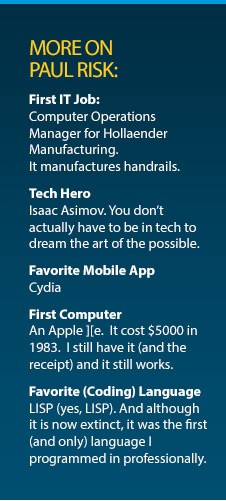
Get your FREE 30-day trial.
Please complete all fields.
The Warranty Group is a leading provider for warranty management, compliance, insurance, and underwriting, for everything from consumer electronics to automotive. Paul Risk joined the company two and half years ago. As the Chief of Global Applications and Architecture, he was brought on specifically to implement Salesforce.
For the latest in our “IT Visionaries” series, Risk shares his “burn the ships” approach for ridding the company of legacy systems, plus his advice for other IT leaders considering a move to the cloud.
When I was interviewing, I told our CIO: “I understand the problem you are facing. You have all these legacy systems in 30 different programming languages and platforms that need an army to maintain them. It’s like a technological Tower of Babel. Innovation has ground to a halt. We can solve this problem by putting everything on Salesforce. All applications can be on a single platform and share objects and fields. Everything will be multi-language, multi-currency, and mobile right out of the box.” Every IT department likes to think of itself as the second coming of IBM, but our job at The Warranty Group is to sell insurance, not to build software. Everything we do in IT needs to be focused on our products and customers – better, cheaper, faster, and a great user experience.
 2. What has the process been like?
2. What has the process been like?It’s been a system transformation, a process transformation, and a people transformation. It has required ripping out and gutting IT, and rebuilding it from the ground up. The other option was to stick with the legacy systems and spend all of our time maintaining them, instead of helping the Business to innovate. But it’s a lot of change. As a company, you need the stomach to go through it.
I can sum this up by sharing what one of the executives at our company told me. “IT has done more in 18 months than had been done in the past 18 years.” App Cloud has enabled us to move at a very fast pace, from development, to fixing any bugs. One thing I’ve personally noticed is when an issue comes up, we know where the problem is, usually within minutes. It used to take days in the old system. Now, nine times out of 10, it’s a quick configuration change that doesn’t involve time consuming coding. We still need to go through change control and a deployment cycle, but it is a lot less painful than it used to be. And thanks to Salesforce Shield, we are able to keep close tabs on who does what in the org.
We’ve built a solution for consumers to purchase many of our products online in conjunction with our client relationships or if they missed the opportunity at the original point of sale. At the same time, the solution needed to capture all of the data around each warranty, so it could be easily accessed by our claims center. The site also had to be configurable to any electronic device to meet consumers’ expectations. Powered by Heroku, we built a mobile interface where customers can submit a photo of their receipt, create an account, select a warranty and purchase it, all from their smartphones. And with Heroku Connect, all of this information goes straight into Salesforce in real-time. The entire solution was built in about six months.
Another advantage of App Cloud is that we’ve been able to give the Business its own sandbox for building applications. Because Salesforce is used wall-to-wall at The Warranty Group, the UI is familiar. With minimal training, business users can configure fields and build apps without coding. Most, with even the most basic technical acumen, can use Salesforce, but we invested in our business people by sending them to the ADM 201 class if for nothing else than to show them basic development standards to follow. We are just beginning to see what they can discover on their own. Their enthusiasm is through the roof. And then when they need it, IT is a resource for the big, complex, heavy engineering projects.
We have a two-year roadmap for cloud development. IT is working diligently to move completely off all of our legacy systems. We have already built a CPQ engine which will greatly speed the time to market for our products, so it takes hours instead of months. This will give us a huge competitive advantage as an organization. We are also implementing Financial Force for our policy admin billing solution. And at the core of all of this is App Cloud.

Technology is changing very fast. IT needs to get ahead of the curve or it will become irrelevant. IT needs the business; the business needs IT. Work together or look for another job. Everything is moving to the cloud. But which cloud platform you choose makes a huge difference. Every major software provider claims to have a cloud – but all clouds are not created equal. The days of building every app from scratch are over. Find a platform that gets you and your users most of the way there. Then, when the Business needs technical help, IT can offer its expertise. That is how IT shows its value.
The role of technology within an organization is rapidly evolving — and so is the role of the CIO. So how can IT leaders manage this transition and take advantage of rapidly emerging opportunities? Download this e-book to meet 12 visionaries who are leading IT transformations in their organizations.